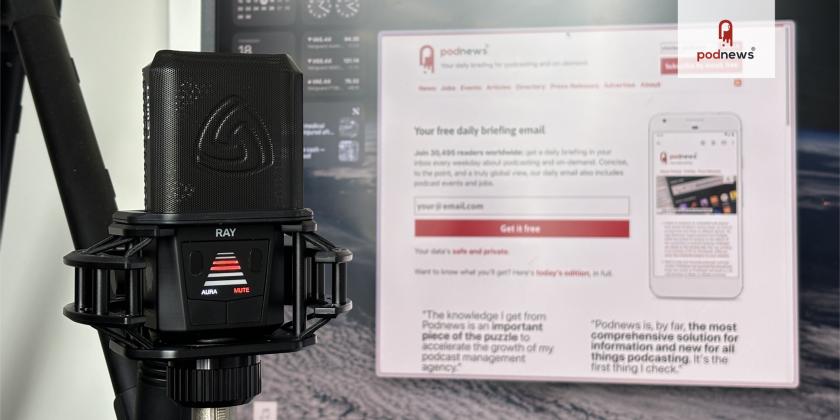
Review: The Lewitt Audio Ray - a microphone with laser-powered autofocus

This article is at least a year old
It’s rare that you see something in microphones that is a new idea, but the Lewitt Audio Ray microphone might just be that - it’s a microphone with a laser in it. No, really, it says so on the box.
The XLR condenser microphone is a side-address microphone in black, with a pretty, green-accented 1” capsule inside as used in their laserless LCT 440 PURE studio microphone. The pickup pattern, as you’d expect, is cardioid polar, with rear rejection. Side-address microphones are good for video, since you can have then close to you but not obstructing your face, and it says something about podcasting these days where it highlights a “camera-ready design”.
It works just fine with any audio interface you might have - using 48v phantom power. I’ve got it plugged into my Focusrite Scarlett 2i2.
But, so far, so ordinary. What’s the difference with this microphone?
What it doesn’t mention on the website, but what it absolutely should, is that this microphone has a class-1 laser inside it. And it’s important for two reasons.
The first reason for the laser: this microphone automatically mutes. You can set it so that if you’re in front of the microphone it works, but as soon as you step away - or even move aside from it, it mutes the signal. This is simple and straightforward, and works well in most cases: the distance is configurable. In my tests, you can lean aside from the microphone to cough, and it automatically mutes as soon as you lean aside from it. It’s quite impressive.
(That means that the microphone also has a mute button: something that you don’t normally see on an XLR microphone. As with most physical mute buttons on a microphone, though, it makes a big clicky noise when you press it.)
But the second reason for the laser is that it compensates for how close you are to the microphone. The marketing calls it “auto-focus for your voice”, and that’s absolutely how it works for the demo video.
In reality - yes, it does work like this. There’s EQ and level adjustment as the device calculates where you are, and keeps your audio level quite well balanced. For my untreated home office - wooden floors, glass windows, and lots of reflective surfaces - it brings up the worst in the room when I’m further away from the microphone; but the tone of my voice doesn’t change, even if it’s clear that I’ve suddenly got a lot more echoey.
In a well-treated studio, this would work very well: particularly if you’re interviewing people who haven’t been trained in microphone technique. It’ll cope happily with someone moving while they speak to you, in a way that many microphones won’t.
One thing to be aware of - if they manage to get their waving hands in between their mouth and the microphone, that’s a recipe for confusion for the sensor.
The display shows six levels of distance, and I was a little concerned that I’d be able to hear the switch between one of those; but the audio seems to switch continuously, and the system avoids any obvious changes. The listener wouldn’t know.
It comes with a decent shock mount, and a magnetic metal pop filter. It also has a fuzzy foam pop filter if you like that sort of thing. The box also contains a padded carry case that I’d absolutely never use; and a fun little secret: you can use the box as a temporary microphone stand, with a strategic hole cut in one side.
Here is the instruction manual, which are linked-to with a QR code on the quick-start guide inside the box.
Who’s the Ray for? It’s probably a great guest microphone in your studio setup: one that will be forgiving of less-than-idea microphone technique. There’s nothing here that you couldn’t do with post-production; but this microphone will make it easy and straightforward to record anyone’s story. And, especially for podcasters, that’s a good thing.
Want to have a listen? Here’s this review, read on the microphone, on the Podnews Extra podcast.
I was sent this microphone for review. Privacy: this page loads an embedded player from Buzzsprout.































































































